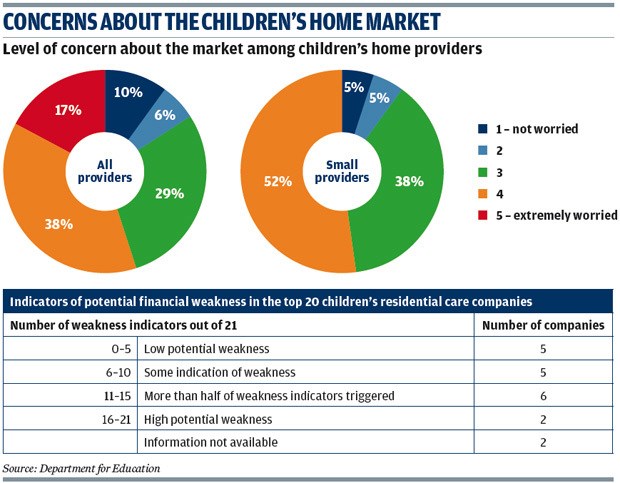Research Report: Financial Stability, Cost and Value for Money in Children's Residential Care
Charlotte Goddard
Monday, July 20, 2015
Author: Institute of Public Care, Oxford Brookes University
Published by: Department for Education, June 2015
SUMMARY
Researchers from Oxford Brookes University were commissioned by the Department for Education to examine the financial stability of the main operators in the children's residential care market. The team carried out 51 interviews with the largest children's homes providers, investors, local authority commissioners, and other organisations for the study - Financial Stability, Cost Charge and Value for Money in the Children's Residential Care Market. They also ran focus groups with 58 people from 46 organisations, carried out telephone interviews with 50 providers and analysed financial data from 40 companies.
Around a third of local authorities do not now run their own homes. As of 31 March 2014, the private sector ran 73 per cent of all children's homes with six per cent run by the voluntary sector. The market had around 402 different providers, with 70 per cent owning just one or two homes. The largest 20 providers, making up five per cent of the total, owned 37 per cent of the private and voluntary homes. The largest provider owned 10 per cent of the homes.
All providers said the degree of difficulties among the children referred to them had increased with particular mention of gangs and child sexual exploitation. There was wide variability in the approach to pricing, ranging from individualised menus of options to one standard price. Interviewees said in general prices were static or falling. None of the large providers saw having homes in London as viable due to high property and employment costs.
There were widely differing views about how sustainable the market is. Some providers said they were struggling and only managing to survive by diversifying their product range, closing their least profitable homes, driving greater efficiencies, or accepting a lower price for care. However, local authority commissioners indicated they were not worried about the financial health of providers and none knew of a home going out of business. They said the main requirements for future residential care placements were local placements, placements for those with high-risk behaviours such as going missing, and specialist placements to meet needs such as substance abuse.
The researchers put together a list of 21 potential weaknesses and analysed the accounts of the top 20 providers. They found eight companies demonstrated more than half the list of weaknesses, with two companies showing more than 16. Five companies showed some indication of weakness with six to 10 indicators, while five companies had less than five indicators.
When the next 20 providers - mostly run by charities - were subjected to the same 21-indicator test, they fared better than their private sector counterparts, perhaps because running children's homes is often supported by other activities such as social housing, and subsidised in some cases by charitable income. However, 75 per cent of these providers reported worsening profits or surpluses in their latest accounts.
IMPLICATIONS FOR PRACTICE
The children's homes market has not yet experienced large corporate failures and closures but the researchers say it is certainly not a market that is in a position to attract a new wave of investors. They make a number of suggestions, including testing out new funding models such as social enterprises, and building closer relationships between directors of children's services and heads of residential care providers to improve strategic thinking about the future of the sector. The authors also recommend the establishment of a children's home market review body, which would produce a "state of the market" report every six months.

FURTHER READING
Children's Homes Data Pack, Department for Education, December 2014. National data on outcomes for children living in children's homes, location of homes and ownership, cost and the people who work in them.
Children's Homes: Understanding the Market and the Use of Out of Authority Placements, Emily Munro, Sam McDermid, Katie Hollingworth and Claire Cameron, Childhood Wellbeing Research Centre, January 2014. Research exploring the children's residential care market and local authority commissioning and procurement strategies.
A Census of the Children's Homes Workforce, Alex Thornton, Sarah Hingley, Ed Mortimer, TNS BMRB, January 2015. A snapshot of the children's homes sector in 2013.




